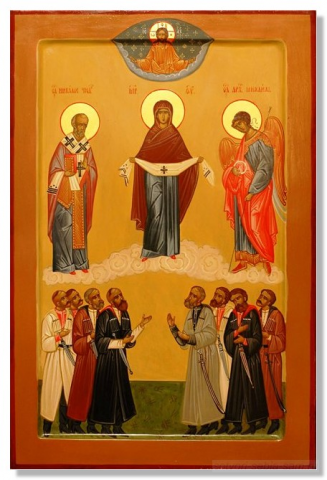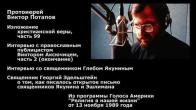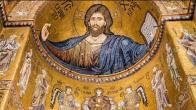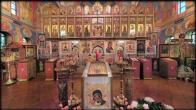You are here
THE PROTECTION OF OUR MOST HOLY LADY THE THEOTOKOS AND EVER-VIRGIN MARY

Troparion
Overshadowed by thy coming, O Mother of God, we the right faithful people, celebrate today with splendor, and gazing at thine all-precious image, we say with compunction: Cover us with thy precious omophorion, and deliver us from all evil, entreating thy Son, Christ our God, that He save our souls.
Kontakion
Today the Virgin standeth forth in the church, and with the choirs of the saints she invisibly prayeth to God for us Angels and hierarchs offer homage, and the apostles and prophets join chorus; for for our sake the Theotokos entreateth the pre-eternal God.
Magnification
We magnify thee, O all-immaculate Mother of Christ our God, and we honor thy labors and thy precious omophorion, for the holy Andrew beheld thee in the air, entreating Christ for us.
The Mother of God and our salvation
“Today the Virgin standeth forth in the Church, and with the choirs of the Saints she invisibly prayeth to God for us. Angels and hierarchs offer homage, and the apostles and prophets join chorus; for our sake the Theotokos entreateth the pre-eternal God.” That is how the Church proclaims the marvelous apparition of the Mother of God that took place in the mid-10th Century, in Constantinople's Blachernae church, the church to which her head-covering – her omophorion – and part of her cincture had been brought from Palestine in the 5th Century. On Sunday October 1 (October 14 on the new calendar), at the fourth hour of the night, when during the All-night Vigil the faithful filled to church to overflowing, St. Andrew, Fool for Christ (commemorated on October 2), lifted his gaze to the heavens and saw our Most-holy Sovereign Lady Theotokos, illuminated by heavenly radiance and surrounded by Angels and a host of Saints, moving through the air. St. John the Baptist and the Holy Apostle St. John the Theologian accompanied the Queen of Heaven. The Most-holy Virgin knelt, and for a long time remained in tearful prayer on behalf of Christians. Then she approached the Altar Table, and continued to pray. At the conclusion of her prayer, she removed her head covering and raised it over the people praying in the church, in token of protection from enemies visible and invisible. The Most-holy Lady shone with a heavenly light, and the omophorion was brighter “than the rays of the sun.” With trepidation, St. Andrew contemplated the marvelous vision, and asked blessed Epiphanios, his disciple standing nearby: “Brother, do you see the Queen and Sovereign Lady, praying for the entire world?” Epiphanios replied, “I see, holy father, and am terrified.” The Most-blessed Theotokos was asking the Lord Jesus Christ to accept the prayers of all who called upon His Most-holy Name and who rushed to her for intercession. Along with the Angels with her in the air, the Most-immaculate Queen prayed, “O Heavenly King, accept everyone praying to Thee and calling upon my name for help, that they not depart from my sight wasted and unheard.” St. Andrew and Epiphanios, who had been made worthy to see the praying Mother of God, “…for a long time gazed upon the covering stretched out over the people and upon the glory of the Lord shining forth like unto lightning. As long as the Most-holy Theotokos was there, the covering was also visible. Once she departed, it too became invisible. However, although she took the omophorion away, she left behind its accompanying grace.” ...That is what Church Tradition passes down to us regarding the Protection of the Most-holy Theotokos, which we celebrate on October 14. What for us is the PROTECTION of the Theotokos, the symbolic appearance of which was revealed to St. Andrew, Fool for Christ, in Constantinople's Blachernae church? The Protection of the Mother of God lies in her being the Mother of God. The Mother of God is that point on earth in which Incarnate God was realized, the point in which He, who had eternally been in God, found His temporary form of existence. The Mother of God is the center of two worlds, the world of the Divine and of the earthly. This is extremely important. It (i.e. the Nativity of God in the world) is what is most important in Christianity. Hence one may say that Christianity is a Theo-tokian religion, a religion of God-birth-giving: Christianity teaches us about how and why God was born in the world. God was born (i.e. was Incarnate) in the world in order to realize and restore/renew the idea, conceived before all ages, of man as the object of His love. In order for the immemorial idea of Theosis (deification, attainment of likeness to or union with God) to be accomplished, God, when creating man, instilled in him His Image and His Likeness. Thereafter, God’s revelation to the world has been in human form: It became possible to talk about God, that is to say about His love, His beauty, His truth, His freedom, by looking upon man. Therefore, biblical concepts and words pertaining to man and attributed to God are not, as some propose, simply naive allegories, but rather comprise a great truth — the truth of the community of God with man: Godliness in man, and humanity in God! The problem is that the first-created man (Adam) fell, and with him and through him, all God's Creation departed from God. In order to return man to the likeness of God, the Son of God, the New Adam, eternal Christ, was sent into the temporal world. Taking upon Himself fallen human nature, He transfigured it and raised it up into the Heavens to God the Father. Thus, for the world lying in evil, Incarnate Christ is “Savior,” but salvation would not have been needed had the first Adam not sinned; then the God-Man/God-Incarnate Christ would not be “Savior,” but would simply be “God-Man/God-Incarnate.” Christ received his human nature from the Ever-virgin Mary. Through her, fallen humanity consented to its restoration, by saying to the Archangel Gabriel, “Behold the handmaid of the Lord; be it unto me according to thy word.” Through the Theotokos, something beyond comprehension, the union of what cannot be joined together - the Creator and His creation - is accomplished. What a wealth of treasure and wisdom and love God has for man! The Creator unites with His creation, and in that union, His creation does not burn to ash in the fire of Divinity. That is the meaning of the Protection of the Mother of God. Because of that protection, the Church attributes to the Mother of God the most beautiful, precious names! What a plethora of terms and poetic comparisons are used to honor the Theotokos and Ever-virgin Mary! Here are some of the liturgical terms that the Church uses to describe the Unwedded Bride, the Virgin Mary: The Mother of God is the Queen of Heaven and the central point of beauty of the earth; she is the flower of the earth, and a hyacinth, azure vase; she is a sweet-sounding lyre, she is a most-holy ark and a sun-bright ray; she is incense and the Spring of grace; she is precious myrrh and a gold/porphyry robe; she is all-holy, and robed in the sun; she is the pearl of the kingdom; she is joy, praise, chanting and glory… She is the power of Divine infiniteness....
Glory to God, Who hath shown us the light, and Who hath given us such an Intercessor!
Archpriest Victor Potapov, October 2013
Relics in cathedral - monthly calendar
| S | M | T | W | T | F | S |
|---|---|---|---|---|---|---|
|
|
|
|
|
|
1
|
2
|
|
3
|
4
|
5
|
6
|
7
|
8
|
9
|
|
10
|
11
|
12
|
13
|
14
|
15
|
16
|
|
17
|
18
|
19
|
20
|
21
|
22
|
23
|
|
24
|
25
|
26
|
27
|
28
|
29
|
30
|
PARISH LIFE
Address of our Cathedral
While all the materials on this site are copyrighted, you may use them freely as long as you treat them
with respect and provide attribution on the Russian Orthodox Cathedral of St.John the Baptist of Washington DC.









